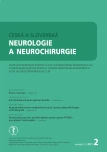Drug induced sleep endoscopy – does a local fi nding in the upper respiratory tract correspond to the severity of sleep apnea syndrome?
Authors:
J. Kalhous- 1 3; J. Kordík 2
Authors‘ workplace:
Klinika ORL a chirurgie hlavy a krku, UJEP, Masarykova nemocnice o. z., Ústí nad Labem, Krajská zdravotní a. s.
1; Centrum pro poruchy dýchání ve, spánku, Masarykova nemocnice o. z., Ústí nad Labem, Krajská zdravotní a. s.
2; UK Hradec Králové
3
Published in:
Cesk Slov Neurol N 2021; 84/117(2): 179-182
Category:
Original Paper
doi:
https://doi.org/10.48095/cccsnn2021179
Overview
Aim: Obstructive sleep apnea syndrome (OSAS) is a common disease in the Czech Republic, and the methods of treatment are positive airway pressure or surgical treatment. Drug induced sleep endoscopy (DISE) is a standard part of the OSAS diagnostic protocol, helping the surgeon determine the site of obstruction in the upper respiratory tract. In our work we deal with the association between the OSAS severity and a local finding in the upper respiratory tract. Materials and Methods: In this work we evaluate a group of 94 patients who underwent DISE. Patients were divided into 3 groups according to the OSAS severity. Group 1 – mild OSAS (apnea-hypopnea index [AHI] 0–14.9), group 2 – moderate severe OSAS (AHI 15–29.9), and group 3 – severe OSAS (AHI ≥ 30). We determined the local finding according to the VOTE classification, i.e., specifically for the sub-localities of the soft palate, oropharynx, tongue root, and epiglottis. We evaluated whether the degree of obstruction in the upper airway was related to the OSAS severity expressed by AHI. We used the Chi-square test for statistical evaluation of individual sub-localities. Results: An association between the degree of obstruction and AHI was found in the areas of the soft palate (Pearson Chi-square: 25.1982; P = 0.000046), oropharynx (Pearson Chi-square: 58.2373; P = 0.000001) and in the area of the tongue (Pearson Chi-square: 15.3935; P = 0.000455). In the area of the epiglottis, no association between the degree of obstruction and AHI was found (Pearson Chi-square: 2.74484; P = 0.601393). Conclusion: DISE is an integral part of the OSAS diagnostic protocol. In our work we showed that the degree of obstruction in 3 out of 4 sub-localities (soft palate, oropharynx, root tongue) corresponded with the OSAS severity. Thus, it is possible to predict the degree of obstruction in the upper respiratory tract area according to the level of AHI, with the exception of the epiglottis area.
Keywords:
drug induced sleep endoscopy – VOTE – NOHL – obstructive sleep apnea syndrome
Sources
1. Garvey JF, Pengo MF, Drakatos P et al. Epidemiological aspects of obstructive sleep apnea. J Thorac Dis 2015; 7(5): 920–929. doi: 10.3978/ j.issn.2072-1439.2015.04.52.
2. Cavaliere M, Russo F, Iemma M. Awake versus drug-induced sleep endoscopy: evaluation of airway obstruction in obstructive sleep apnea/ hypopnoea syndrome. Laryngoscope 2013; 123(9): 2315–2318. doi: 10.1002/ lary.23881. PMID: 24167821.
3. Kezirian EJ, Hohenhorst W, de Vries N. Drug-induced sleep endoscopy: the VOTE classification. Eur Arch Otorhinolaryngol 2011; 268(8): 1233–1236. doi: 10.1007/ s00405-011-1633-8.
4. Cho JS, Soh S, Kim EJ et al. Comparison of three sedation regimens for drug-induced sleep endoscopy. Sleep Breath 2015; 19(2): 711–717. doi: 10.1007/ s11325-015-1127-9.
5. Atkins JH, Mandel JE, Rosanova G. Safety and efficacy of drug-induced sleep endoscopy using a probability ramp propofol infusion system in patients with severe obstructive sleep apnea. Anesth Analg 2014; 119(4): 805–810. doi: 10.1213/ ANE.0000000000000229.
6. Lee CH, Kim DK, Kim SY et al. Changes in site of obstruction in obstructive sleep apnea patients according to sleep position: a DISE study. Laryngoscope 2015; 125(1): 248–254. doi: 10.1002/ lary.24825.
7. Safiruddin F, Koutsourelakis I, de Vries N. Upper airway collapse during drug induced sleep endoscopy: head rotation in supine position compared with lateral head and trunk position. Eur Arch Otorhinolaryngol 2015; 272(2): 485–488. doi: 10.1007/ s00405-014-3215-z.
8. Safiruddin F, Koutsourelakis I, de Vries N. Analysis of the influence of head rotation during drug-induced sleep endoscopy in obstructive sleep apnea. Laryngoscope 2014; 124(9): 2195–2199. doi: 10.1002/ lary.24598.
9. Vicini C, De Vito A, Benazzo M et al. The nose oropharynx hypopharynx and larynx (NOHL) classification: a new system of diagnostic standardized examination for OSAHS patients. Eur Arch Otorhinolaryngol 2012; 269(4): 1297–1300. doi: 10.1007/ s00405-012-1965-z.
10. Eichler C, Sommer JU, Stuck BA el al. Does drug-induced sleep endoscopy change the treatment concept of patients with snoring and obstructive sleep apnea? Sleep Breath 2013; 17(1): 63–68. doi: 10.1007/ s11325-012-0647-9.
11. Fernández-Julián E, García-Pérez MÁ, García--Callejo J et al. Surgical planning after sleep versus awake techniques in patients with obstructive sleep apnea. Laryngoscope 2014; 124(8): 1970–1974. doi: 10.1002/ lary.24577.
12. Hong SD, Dhong HJ, Kim HY et al. Change of obstruction level during drug-induced sleep endoscopy according to sedation depth in obstructive sleep apnea. Laryngoscope 2013; 123(11): 2896–2899. doi: 10.1002/ lary.24045.
13. Hybášková J, Jor O, Novák V et al. Využití spánkové endoskopie pro zvýšení efektivity léčby (operační i neoperační) u pacientů s obstrukční spánkovou apnoí. Cesk Slov Neurol N 2017; 80/ 113(4): 428–433. doi: 10.14735/ amcsnn2017428.
14. Vicini C, Colabianchi V, Giorgio Marrano G et al. Description of the relationship between NOHL classification in drug-induced sleep endoscopy and initial AHI in patients with moderate to severe OSAS, and evaluation of the results obtained with oral appliance therapy. Acta Otorhinolaryngol Ital 2020; 40(1): 50–56. doi: 10.14639/ 0392-100X-2290.
15. Belgü AU, Erdoğan B, San T et al. The relationship between AHI, Epworth scores and sleep endoscopy in patients with OSAS. Eur Arch Otorhinolaryngol 2015; 272(1): 241–245. doi: 10.1007/ s00405-014-3220-2.
16. Torre C, Camacho M, Liu SY et al. Epiglottis collapse in adult obstructive sleep apnea: a systematic review. Laryngoscope 2016; 126(2): 515–523. doi: 10.1002/lary.25589.
Labels
Paediatric neurology Neurosurgery NeurologyArticle was published in
Czech and Slovak Neurology and Neurosurgery

2021 Issue 2
Most read in this issue
- Morton’s neuralgia, metatarsalgia
- Moyamoya disease
- Correct and incorrect naming of pictures for the more demanding written Picture Naming and Immediate Recall test (door PICNIR)
- Etiopathogenesis and diagnostics of progressive multifocal leukoencephalopathy in patients treated with natalizumab
